Physical Address
304 North Cardinal St.
Dorchester Center, MA 02124
Retrorectal tumors comprise an uncommon group of lesions, originating from one or more of the three germ cell layers that occupy the retrorectal or presacral space. The reported incidence of less than 1% likely represents an underestimate, given the indolent nature of these tumors with often vague and nonspecific symptoms. Tumors are often heterogeneous and are more often congenital than acquired. Given the complexity of pelvic anatomy and the frequent involvement of multiple pelvic structures, a multidisciplinary surgical team is often required for safe and effective management. Appropriate surgical planning with the aid of preoperative imaging and selective biopsy of these lesions has allowed for safe use of neoadjuvant chemoradiation. This, coupled with the employment of multidisciplinary teams, has led to generally favorable outcomes in these patients.
Given the bony confines of the pelvis and its complex gastrointestinal, genitourinary, neurologic, and vascular anatomy, tumors arising in the retrorectal space often involve multiple structures ( Fig. 174.1 ). Retrorectal tumors can grow to fill the pelvis and lead to displacement of pelvic organs. The mesorectum forms the anterior border of this space, and the anterior aspect of the sacrum forms the posterior border. Superiorly, the space extends to the peritoneal reflection and inferiorly to the rectosacral fascia. Laterally, the retrorectal space is bounded by the lateral ligaments, the ureters, and the iliac vessels. The retrorectal space itself contains loose connective tissue, the middle sacral artery, superior hemorrhoidal vessels, and branches of sympathetic and parasympathetic nerves. Vascular and neural structures originate or traverse in proximity to this area and may give rise to, or be involved by, retrorectal tumors ( Fig. 174.2 ).
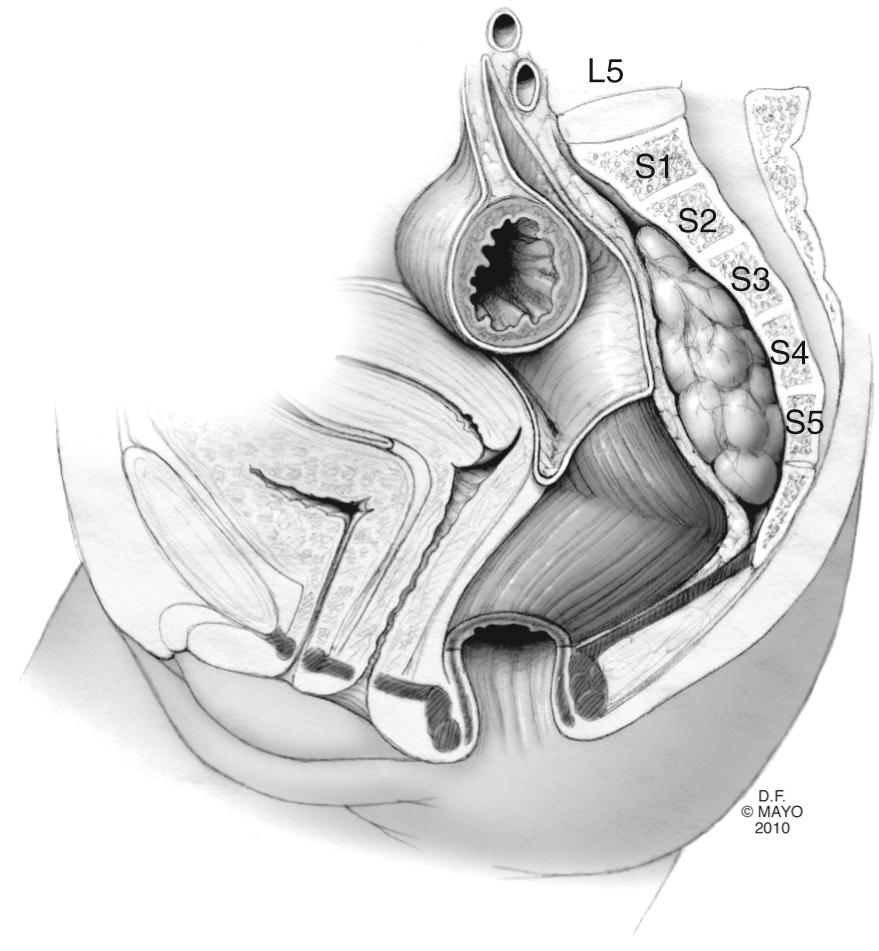
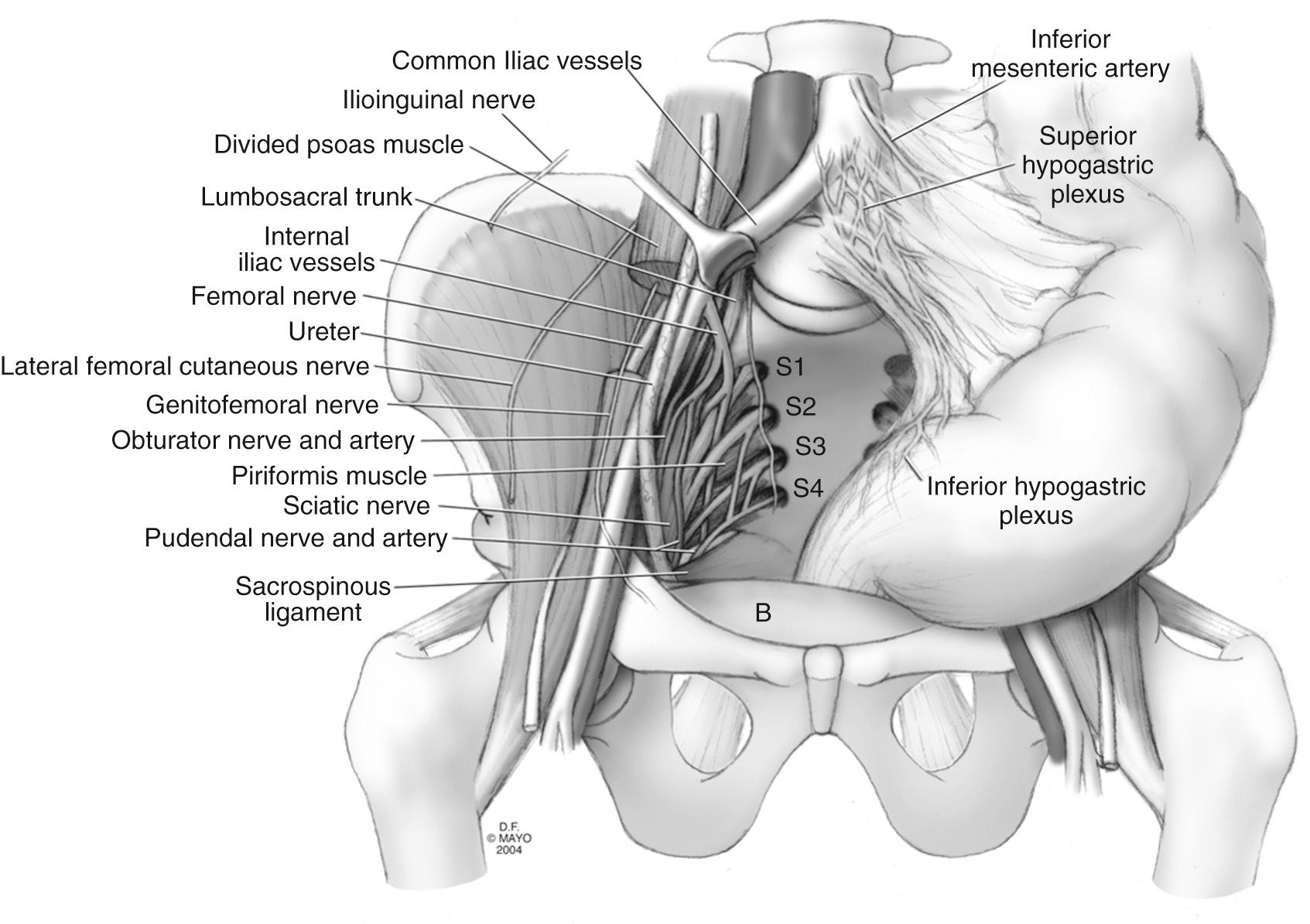
Vascular involvement can often be managed by either ligation or reconstruction, with little clinical sequelae. Management of neural involvement may be more complex and requires knowledge of sacral root function to counsel patients adequately regarding potential functional deficits. If all sacral roots are sacrificed unilaterally, normal anorectal function is preserved, and a sphincter-sparing operation may be considered if oncologically appropriate. Similarly, if the upper three sacral roots (S1 to S3) remain intact on either side of the sacrum, the patient will still maintain spontaneous defecation and control of anorectal function. If bilateral S3 roots are sacrificed or damaged, anal incontinence and poor defecatory function will result, and a permanent colostomy should be considered.
Pelvic surgery may also result in sexual or urologic dysfunction. Injury to the hypogastric nerves may result in retrograde ejaculation and/or bladder dysfunction. The risk for injury is highest during ligation of the inferior mesenteric artery at its origin, and during mobilization of the rectum near the sacral promontory. The nervi erigentes course anteriorly within the lateral stalks of the rectum and contain parasympathetic fibers from S2 to S4. Injury to these nerves will lead to erectile dysfunction. Finally, the pudendal nerve (S2 to S4) extends inferiorly to the perineum and has two branches—a sensory branch supplying the skin of the penis and glans and a motor branch innervating the external anal sphincter. Unilateral pudendal nerve injuries generally do not result in incontinence, as there is cross innervation at the level of the spinal cord.
Sacrectomy may be required if there is bony involvement by the tumor, or in some circumstances, to gain access to the pelvis for complete resection. This requires the surgical team be familiar with the anatomy of the sacrotuberous and sacrospinous ligaments ( Fig. 174.3 ), sciatic nerve, piriformis muscle ( Fig. 174.4 ), and the thecal sac and sacral nerve roots ( Fig. 174.5 ). In our practice, we incorporate the skills of both an oncologic orthopedic surgeon and a spine surgeon to assist in operations requiring sacrectomy. When the majority of the sacrum is removed, pelvic stability can be maintained if more than half of the S1 vertebral body is preserved. Because stress fractures to this remnant may occur if preoperative radiation has been used, preservation of spinopelvic stability may require fusion.
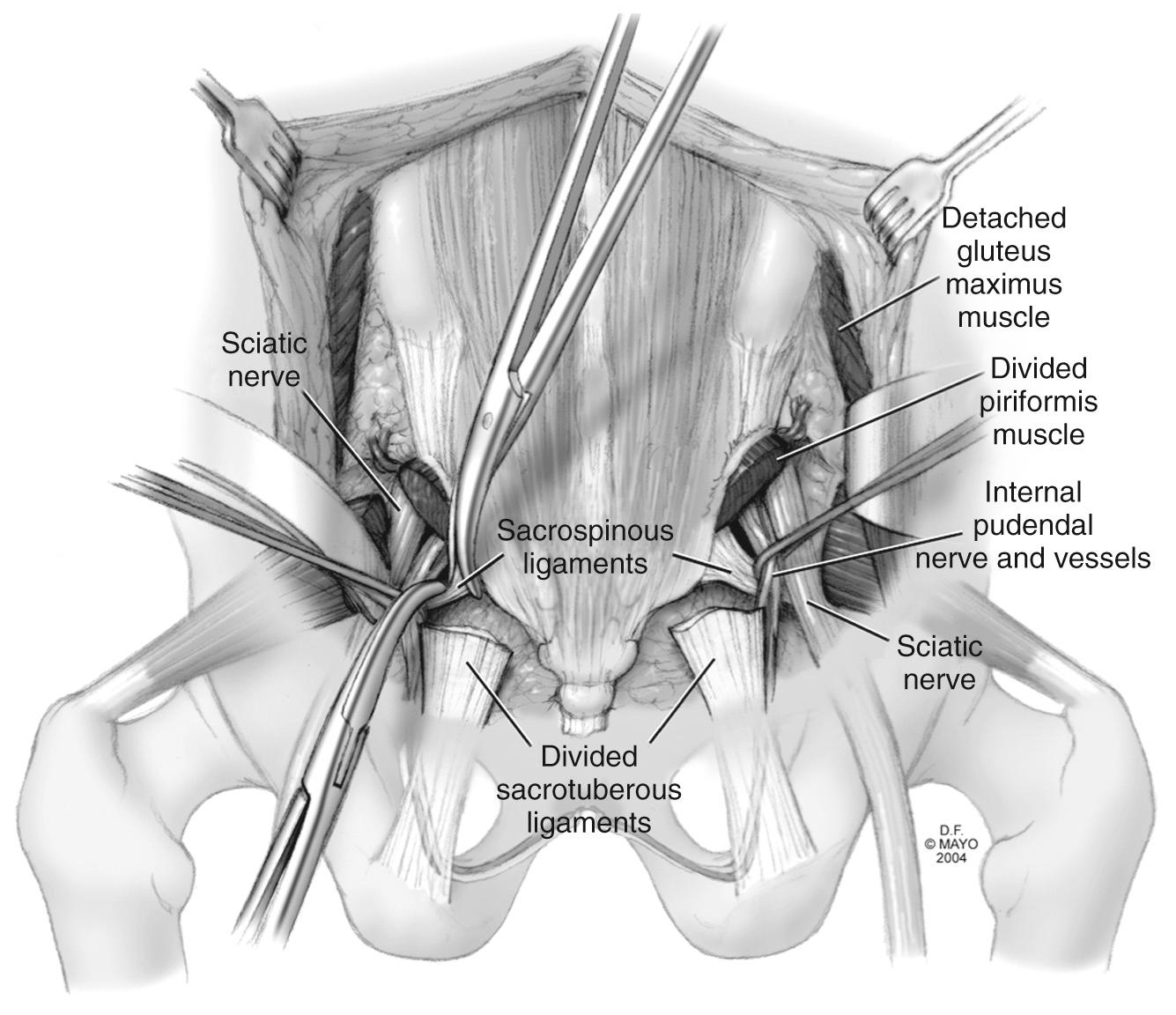
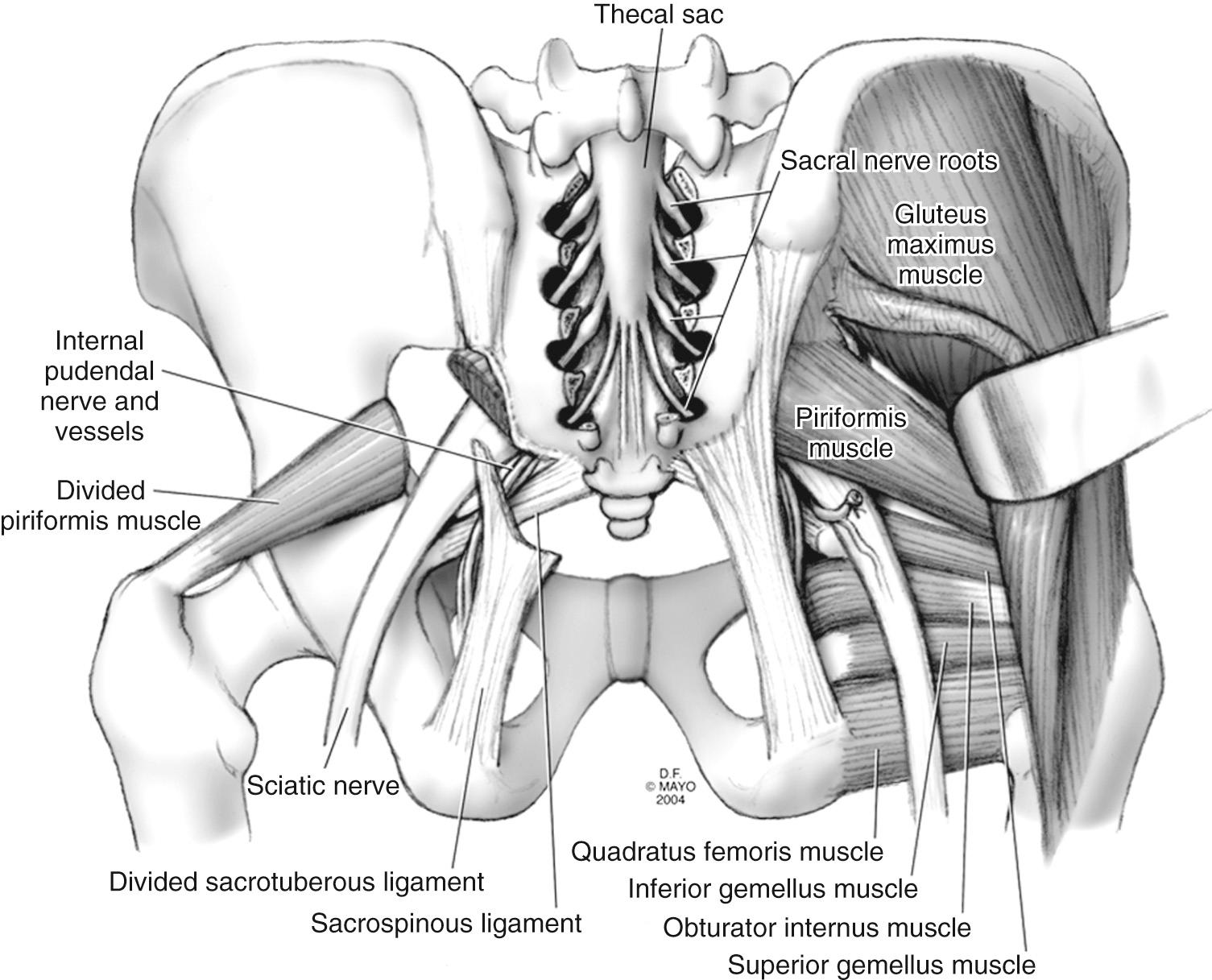
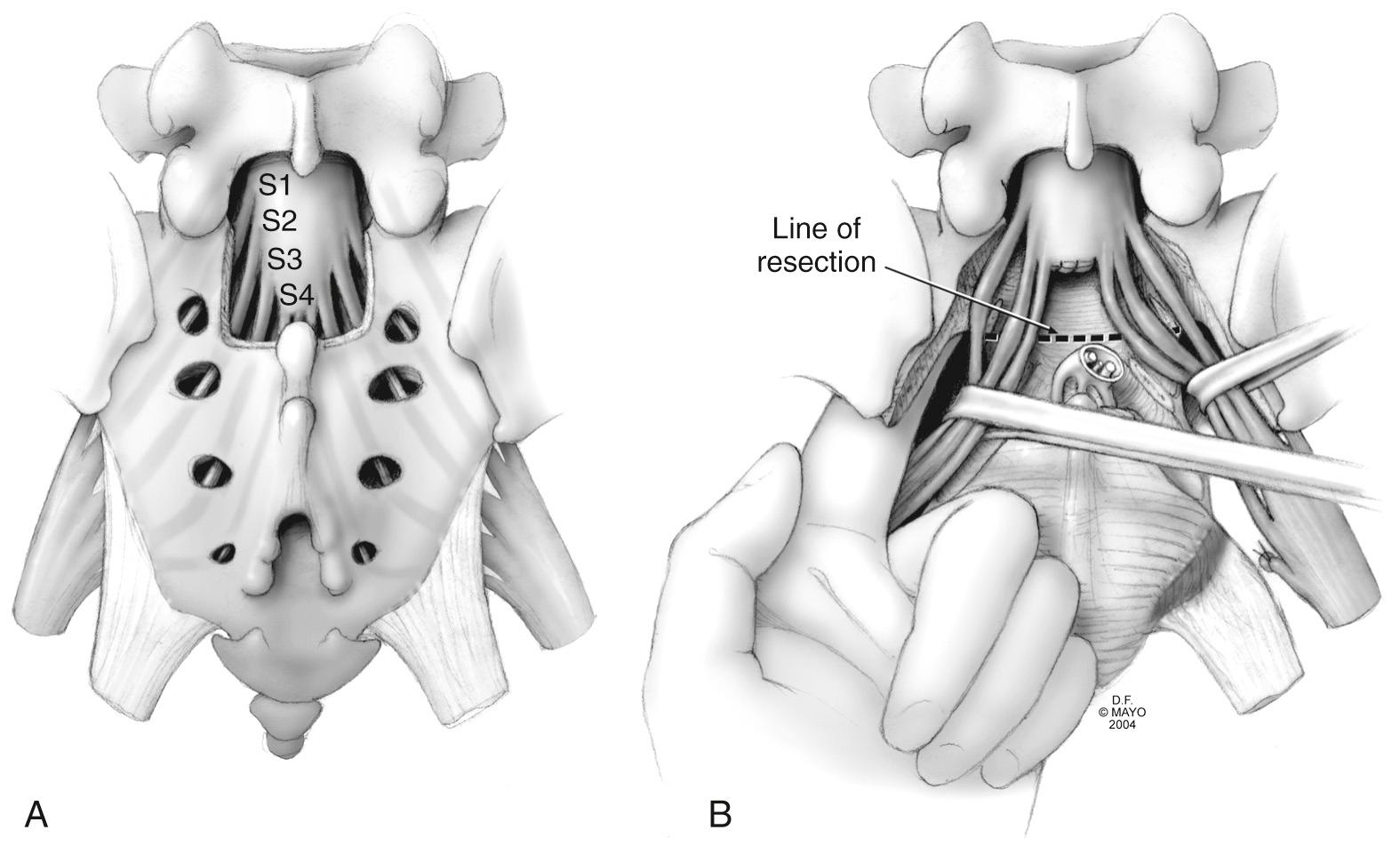
These tumors have been comprehensively classified according to each potential cell line. This has been previously modified by Dozois et al. to further classify these tumors into malignant and benign status because this has significant clinical implications ( Box 174.1 ). In general, the majority of tumors are congenital in origin, of which most are developmental cysts. These may originate from any of the three germ layers and include epidermoid and dermoid cysts, enterogenous cysts, tailgut cysts (TGCs), and teratomas. Cystic lesions are seen most commonly in women, and most solid lesions are either chordomas or sarcomas. Malignancy is more common in men, even though the majority of retrorectal tumors occur in women.
Benign
Developmental cysts (teratoma, epidermoid, dermoid, mucus secreting)
Duplication of rectum
Anterior sacral meningocele
Adrenal rest tumor
Malignant
Chordoma
Teratocarcinoma
Benign
Neurofibroma
Neurilemoma (Schwannoma)
Ganglioneuroma
Malignant
Neuroblastoma
Ganglioneuroblastoma
Ependymoma
Malignant peripheral nerve sheath tumors
Benign
Giant cell tumor
Osteoblastoma
Aneurysmal bone cyst
Malignant
Osteogenic sarcoma
Ewing sarcoma
Myeloma
Chondrosarcoma
Benign
Lipoma
Fibroma
Leiomyoma
Hemangioma
Endothelioma
Desmoid
Hemangiopericytoma
Malignant
Liposarcoma
Fibrosarcoma/malignant fibrous histiocytoma
Leiomyosarcoma
Metastatic carcinoma
Other
Ectopic kidney
Hematoma
Abscess
Symptoms associated with retrorectal tumors are often vague and ill defined. Tumors may be discovered incidentally on routine pelvic or rectal examination. Symptoms may include pelvic or low back pain, constipation, a palpable mass, or obstructive type symptoms. Classically, this pain is aggravated by sitting and ameliorated by standing or walking. However, pain is an ominous sign and has been described as being present more commonly when the lesion is malignant than benign (88% vs. 39%). One should be concerned about a potentially more advanced tumor when symptoms include urinary or fecal incontinence and sexual dysfunction because sacral nerve involvement may be present.
Occasionally, patients may have persistent perianal discharge and have been misdiagnosed with chronic perianal fistula or pilonidal disease. Circumstances that should alert the examiner to the possibility of a retrorectal cystic lesion as a cause of this presentation include repeated operations for “anal fistula,” inability to uncover a primary source of infection at the dentate line, recurrent infection of the retrorectal space without obvious cause, presence of a postanal dimple, and fullness and fixation of the precoccygeal area.
A careful and focused perineal and anorectal physical examination is necessary. Although rare, the presence of a postanal dimple should alert the clinician to the possibility of an underlying retrorectal mass. The majority of patients have a palpable mass on digital rectal examination because the rectum tends to be displaced anteriorly. The overlying rectal mucosa is usually smooth and mobile; absence of this feature overlying the mass is suggestive of prior infection of a cystic lesion that has discharged through the rectum or of advanced malignancy. The rectal examination is also important in evaluating for fixation and determining the level of the tumor in relation to the coccyx and other structures such as the prostate. A complete neurologic evaluation should be completed and focused on the sacral nerves and musculoskeletal reflexes, impairment of which may indicate the presence of sacral nerve involvement.
Retrorectal masses should undergo a focused physical examination, high-resolution cross-sectional imaging, and percutaneous biopsy of solid or heterogeneous tumors. Plain radiographs of the sacrum are of limited use and computed tomography (CT) and/or magnetic resonance imaging (MRI) should be used preferentially. However, when obtained, plain films may identify bone destruction, calcification, and soft tissue–occupying masses—features commonly seen with chordoma, giant cell tumors, neurilemoma, aneurysmal bone cysts, and osteochondroma. A “scimitar” sign on sacral views (or sickle-shaped sacrum) is a classic feature seen in association with anterior sacral meningocele, a diagnosis that must be confirmed with myelography or contrast-enhanced MRI.
Cross-sectional imaging, particularly with CT, allows for defining tumors as cystic, solid, or heterogeneous (solid and cystic components). It is important to evaluate if other pelvic structures, such as the bladder, uterus, ureters, or rectum, are involved. CT best demonstrates cortical bone destruction, whereas MRI is superior in evaluation of marrow involvement. Moreover, we find MRI, due to a high degree of soft tissue resolution, is helpful in defining the complete extent of the tumor and involvement of adjacent structures and assists greatly in surgical planning. Spinal imaging is best performed by MRI, which may demonstrate meningocele, nerve root, and foraminal involvement by tumor and thecal sac compression. MR angiogram or venogram may add additional information regarding vascular involvement and, if present, should prompt the involvement of a vascular surgeon. Based on several studies, MRI appears to be more accurate than CT imaging in determining malignant from benign lesions.
Become a Clinical Tree membership for Full access and enjoy Unlimited articles
If you are a member. Log in here